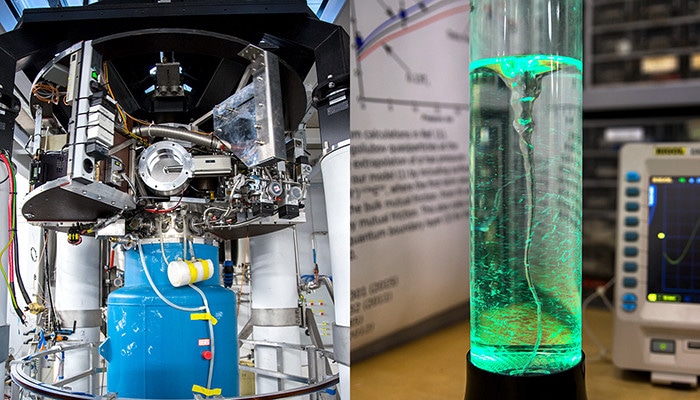Feb 5 2018
Understanding the effects and causes of friction could make room for explorations into the composition of the universe and neutron stars. Here on Earth, the Aalto researchers’ results will be invaluable for limiting the production of heat and unwanted glitches in quantum computer components.
 Rotating cryostat with the superfluid helium near absolute zero (left); a novelty model of a vortex inside a container (right), similar to the one inside the cryostat. The actual vortices are perfectly even, whereas in the model, the vortex varies in thickness. (Image credit: Aalto University/Tapio Reinekoski)
Rotating cryostat with the superfluid helium near absolute zero (left); a novelty model of a vortex inside a container (right), similar to the one inside the cryostat. The actual vortices are perfectly even, whereas in the model, the vortex varies in thickness. (Image credit: Aalto University/Tapio Reinekoski)
“For now, we have to study the phenomenon itself more in depth, before we can have insight exhaustive enough to be applied to experimental research and developing technologies,” notes Jere Mäkinen, Doctoral Researcher at Aalto University.
The researchers have rotated a container containing superfluid helium-3 isotopes near absolute zero temperature. The rotating fluid mimics the motion of solid bodies, developing tiny, identical hurricanes known as vortices.
When the vortices are in ordered and stable laminar motion at zero temperature, as opposed to limitlessly chaotic turbulence, there should be no friction or even means for a vortex to transfer any kinetic energy to its surroundings.
However, that is exactly what Mäkinen and his supervisor, Dr. Vladimir Eltsov, have presently found to happen.
What we suspect could be a source of the friction are quasi-particles trapped in the cores of the vortices. When the vortices accelerate, the particles gain kinetic energy which dissipates to surrounding particles and creates friction.
Jere Mäkinen, Doctoral Researcher at Aalto University
In turbulent systems, kinetic energy always dissipates from the motion of vortices, but up to now everyone had thought that when vortices are in laminar motion the dissipation of energy is zero at zero temperature. But it turns out, it’s not.
Dr. Vladimir Eltsov
Mäkinen compares the dissipation of heat to shaking a box filled with table tennis balls: they gain kinetic energy from the other balls bouncing around and the moving box.
Avoiding the vortices from dissipating heat and thus friction, would, for instance, improve the performance of and the potential to retain data in superconducting components employed for constructing quantum computers.
A Neutron Star in a Lab – The First Step Towards Understanding Turbulence
The holy grail of studies on quantum turbulence is to understand and then explain turbulence in everyday gases and liquids. The work of Mäkinen and Eltsov is a primary step towards coming to grips with the inner workings of vortices in superfluids. From there, it is possible for one move on to comprehending turbulence in the everyday environment, in a ‘classic’ state.
The implications could spin around entire industries. New ways to enhance aerodynamics of vehicles and planes of all kinds or controlling the flow of gas or oil in pipelines, just to mention a few.
Mysteries of the universe are also enclosed in these experiments. Collapsed, massively heavy neutron stars are believed to comprise of complex superfluid systems. Glitches and abnormalities like unexpected changes in the stars’ rotation speed, could be brought about by bursts of vortices and similar energy dissipation to the one presently discovered in the experiments at Aalto University.